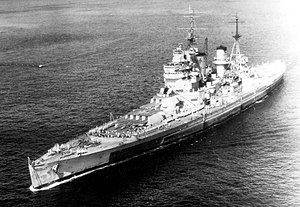
Back HMS King George V AF Кинг Джордж V (линеен кораб, 1939) Bulgarian HMS King George V (41) Catalan HMS King George V (41) Czech King George V (Schiff, 1940) German HMS King George V (41) Spanish HMS King George V (41) Finnish HMS King George V (41) French אה"מ קינג ג'ורג' החמישי (1939) HE HMS King George V (41) Croatian
 HMS King George V enters Apra Harbour, Guam with sailors on deck in 1945
| |
| History | |
|---|---|
| Name | HMS King George V |
| Namesake | George V |
| Builder | Vickers-Armstrong, Newcastle upon Tyne, United Kingdom |
| Laid down | 1 January 1937[1] |
| Launched | 21 February 1939[1] |
| Commissioned | 1 October 1940[1] |
| Decommissioned | 1949 |
| Stricken | 17 December 1957[1] |
| Nickname(s) | KGV |
| Honours and awards | |
| Fate | Sold for scrap, 1957 |
| Notes | Pennant number 41[2][1] |
| General characteristics | |
| Class and type | King George V-class battleship |
| Displacement | 42,200 tons (1941) |
| Length | 745 ft (227 m) |
| Beam | 103 ft (31 m) |
| Draught | 32.6 ft (9.9 m) |
| Propulsion |
|
| Speed | 28.0 knots (51.9 km/h) (1941 trials) |
| Range | +5,400 nautical miles (10,000 km) at 18 knots (33 km/h) (11.9 tons/hour fuel burn) |
| Complement | 1,314 to 1,631 |
| Armament |
|
| Armour |
|
| Aircraft carried | 4 Supermarine Walrus seaplanes, 1 double-ended catapult |
HMS King George V (pennant number 41) was the lead ship of the five British King George V-class battleships of the Royal Navy. Laid down in 1937 and commissioned in 1940, King George V operated during the Second World War in all three major naval theatres of war, the Atlantic, Mediterranean and Pacific, as part of the British Home Fleet and Pacific Fleets. In May 1941, along with HMS Rodney, King George V was involved in the hunt for and pursuit of the German battleship Bismarck, eventually inflicting severe damage which led to the German vessel's sinking. On 1 May 1942 the destroyer HMS Punjabi sank after a collision with King George V in foggy conditions. King George V took part in Operation Husky (the allied landings in Sicily) and bombarded the island of Levanzo and the port of Trapani. She also escorted part of the surrendered Italian Fleet, which included the battleships Andrea Doria and Duilio, to Malta. In 1945 King George V took part in operations against the Japanese in the Pacific.
King George V was made flagship of the British Home Fleet on 1 April 1941, she remained so during the rest of the war and became a training battleship in November 1947.[1]